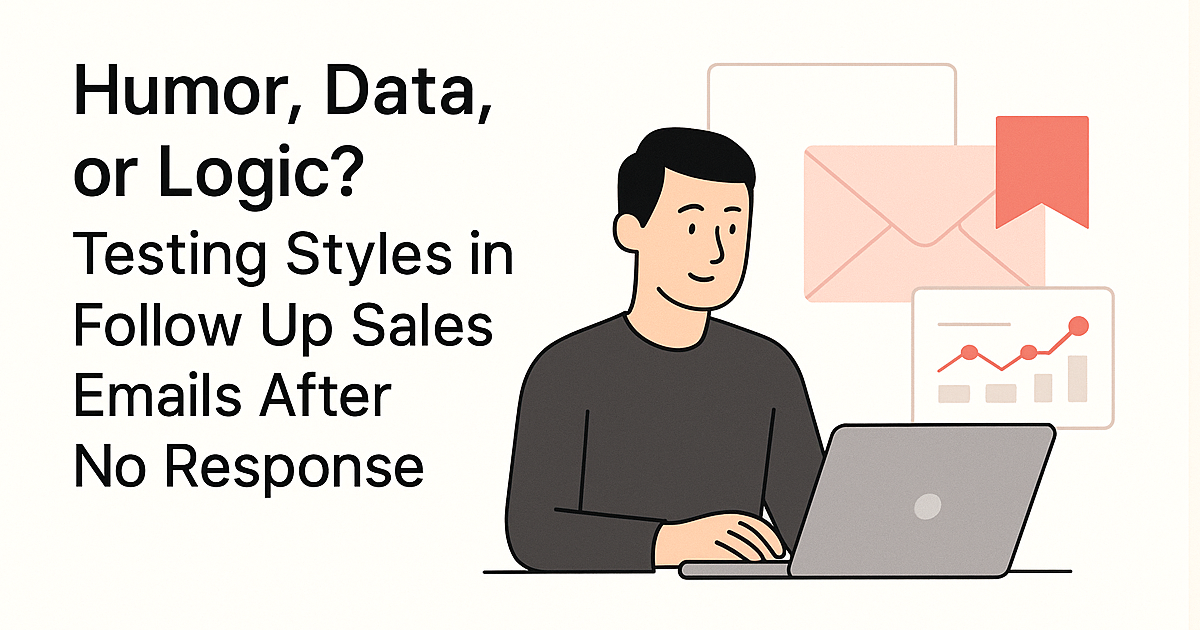Follow-up emails help reignite interest, clarify doubts, and show persistence without being pushy. They can often turn silence into meaningful conversations.

When you send a follow-up sales email and hear nothing but crickets, it can be tough. You might wonder, “Did they miss it? Did it vanish into the spam folder abyss?” Dropping a second line needs more than just a gentle nudge. It requires a strategy—one that might involve humor, data, or straightforward logic—to break through the silence and truly connect. Let’s dive into how these approaches can shift gears in your follow-up emails and ultimately boost those elusive response rates.
You’ve reached out, and no dice. So, why hit “send” again? Well, here’s the scoop—just because someone doesn’t get back initially doesn’t mean they’re not interested. They’ve probably just…well, forgotten, or maybe got distracted. According to HubSpot’s magic numbers, about 70% of deals slip away because follow-ups stop way too early. Rushing a sale is like trying to eat soup with a fork—frustrating and messy.
Follow-up emails have a few missions:
Sales emails often flop because they feel like déjà vu or sound like another notch in the spam file. Crafting the right follow-up style—be it witty, stat-packed, or purely logical—is like finding that elusive missing puzzle piece.
”Testing” isn’t just jargon here. It’s all about playing detective to figure out what really gets people clicking and replying.
I once worked with a sales team that decided to run a little experiment: humor versus logic in their follow-ups. Over three months, the funnier emails enjoyed a 23% uptick in open rates, while the logical ones saw response rates soar, especially among C-suite crowds. Fascinating stuff!
Introducing humor might seem like a bit of a gamble, but when it sticks, it’s worth its weight in gold. Among the sea of sameness, it makes your email pop.
Humor is magical. It breaks down that awkward wall and eases people in. Think of it as a handshake with a good-natured jest.
Just make sure your humor matches your brand vibe and the audience you’re reaching. Push it too far, and you risk confusing—or worse, offending—your prospects.
Here’s a fun one: A tech company decided to use the subject line, “Are we ghosting each other?”—complete with a little ghost emoji. Inside, they made light of “haunted inboxes” and lightly rephrased what makes their product shine. The result? An 18% jump in replies.
You might think data is dry, dull, and destined to put people to sleep. But nope! When wielded right, it’s the ace up your sleeve.
Data isn’t just numbers; it’s insights, patterns, and proof. It shows you’re not shooting from the hip. You’re informed. Prepped. Ready.
Salesforce gave it a shot: peppering their follow-ups with stats on customer successes. One email went like this: “Companies using our platform saw conversion rates soar by 35% in just three months.” That line alone boosted their replies by 27%. Talk about a home run!
While those numbers ground your message in proof, too much, and you’re wading into snooze territory. Strike that balance with a chatty tone.
Logic says, “I get it. I’m here to help you solve this.” It’s the calm whisper in a sea of pitches that gets prospects nodding along in agreement.
One B2B service firm tossed their sales-y emails for logic-driven strategies and watched as their engagement metrics surged. More booked demos, more interest, and more handshakes.
Follow-up emails aren’t just about firing off another nudge. They’re strategic, they evolve, and they’re tailored—when you get them right, they turn silence into conversation and talks into deals.
Whether you raise a smile with humor, support your message with data, or flesh out a logical case, the only way to strike gold is to try new things. Measure every little tweak, and don’t be afraid to break the routine. Personalize, pivot, test—and conquer!
So ready to experiment? Need help setting up your email campaigns or figuring out what makes your prospects tick? Let’s chat. Let’s dig into strategies that fit like a glove for your sales team, helping that pipeline of yours flow just the way it should.
Bring your follow-ups to life, and watch them work wonders.
Follow-up emails help reignite interest, clarify doubts, and show persistence without being pushy. They can often turn silence into meaningful conversations.
Humor helps break the ice, adds personality to your brand, and makes your emails stand out. Just ensure it matches your audience and stays professional.
Data builds credibility and shows prospects that your claims are backed by evidence. Sharing stats, benchmarks, or case studies can increase response rates.
A logic-first email works best when your audience values clarity, solutions, and efficiency. It outlines the problem, offers a solution, and provides proof of success.
Run A/B tests, focus on one variable at a time, and track clear goals such as clicks or replies. Use feedback and data to refine your approach.
We’re here to help. Whether it’s about features, pricing, or getting started with InboxPlus